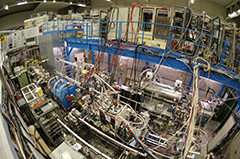
The apparent lack of primordial antimatter in the universe is one of the great mysteries of science today.
As part of efforts to resolve this mystery, RIKEN scientists working on the international ASACUSA collaboration have used the CERN facilities in Europe to successfully create a beam of antihydrogen atoms.
The RIKEN researchers, including Yasunori Yamazaki of the RIKEN Atomic Physics Laboratory and Stefan Ulmer of the Ulmer Initiative Research Unit co-authored a paper published in Nature Communications describing the detection of 80 antihydrogen atoms 2.7 meters from the place where they were produced, which is a major step towards allowing precise spectroscopy of antihydrogen atoms to be done.
The beam will eventually be used to measure the hyperfine structure of antihydrogen, which is equivalent to hydrogen but is made up of antimatter particles, namely antiprotons and positrons. If a small difference is found in the planned spectroscopy experiments, it could explain the striking imbalance between matter and antimatter observed on cosmological scales, and provide an answer to the fundamental question: why do we exist at all?
In 2011, the ASACUSA collaboration made headlines by successfully producing antihydrogen atoms in a cusp trap, which made the results reported today possible.
The study is published in Nature Communications, doi:10.1038/ncomms4089
